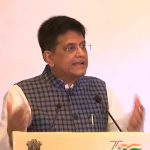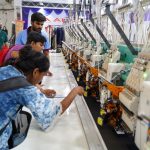 Thanks to PM Narendra Modi’s ‘Make In India’ call (‘Tiger’s Call’, if you so like), there has been a flood of seminars, conferences, workshops and what not, throughout the country and overseas. At a similar Seminar on ‘Strategy for Making India a Global Leader in Textiles and Apparels’ last month, textile minister Santosh Kumar Gangwar hinted at government’s intentions to come out with a ‘new long term’ Textile Policy to make India globally competitive. The reasons provided by the minister were same as those applicable for any other industry sector in the country such as : skill upgradation, rationalization of labour cost, speeding up customs clearance and reduction in the cost of capital.
Thanks to PM Narendra Modi’s ‘Make In India’ call (‘Tiger’s Call’, if you so like), there has been a flood of seminars, conferences, workshops and what not, throughout the country and overseas. At a similar Seminar on ‘Strategy for Making India a Global Leader in Textiles and Apparels’ last month, textile minister Santosh Kumar Gangwar hinted at government’s intentions to come out with a ‘new long term’ Textile Policy to make India globally competitive. The reasons provided by the minister were same as those applicable for any other industry sector in the country such as : skill upgradation, rationalization of labour cost, speeding up customs clearance and reduction in the cost of capital.
Now let’s have a look at the way our existing policies work.
A glance at the ministry’s own figures reveals that out of the proposed outlay of Rs.40,203.19 crore by the MoT for the 12th Five year Plan, the total expenditure during the first three years of the Plan period i.e 2012-13, 2013-14 and 2014-15 (upto 15th February, 2015) was Rs.9,561.65 crore -less than 40% of the approved outlay. The reason (given by the MoT itself) for this is the procedural delays in sanctioning and implementing the major Schemes.
So, the entire idea of coming out with a new Textile Policy is centered around speeding up the procedures involved in sanctioning and implementing what has already been worked out under the existing policy. That means the sole objective is to maximize the utilization of 12th Plan (already) approved outlay meant for various textiles sector Schemes.
Some other examples of poor governance are :
- In about 50 Schemes/Programmes, during 2013-14, approx. Rs.1,395 crore were surrendered.
- During 2014-15, the likely surrender of funds is going to be around Rs.1,600 crore.
- The Ministry of Finance has now curtailed the plan outlay of Rs.7,818.11 crore for 2015-16 fiscal to Rs.3,523.32 crore.
Ironically, the MoT realizes that reduction in the Budgetary proposals for 2015-16 is due to the trend of lower expenditure during the last few years which has been only around 60%. However, it must be realized that this will adversely affect vital schemes like TUFS, ISDS, SITP, Geotextiles, Agrotextiles, etc. Such reductions in the Budgetary proposals are going to dampen the promotion of textiles industry, skill development activities and overall development in both organized and unorganised sectors.
In a nutshell, the government feels the need for a new Textile Policy to ensure implementation of the existing policy! Just imagine, the ministry is not able to spend the allocated funds for the development of the textile indutry. You may call it ‘strange’ if you want but the main reason for missing the expenditure targets, according to the ministry, is lack of receipt of viable proposals from the States and from the Implementing Agencies.
If we apply our mind on the above facts, then one can clearly say that what is really required is a new Plan and Action (as per the Plan) to achieve the objectives of whatever Textile Policy we have or we are going to have. We have had enough of policies what we now require is workable Plan and an efficient Action on that Plan.
G.D. JASUJA
Managing Editor





